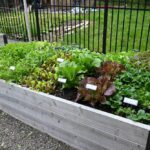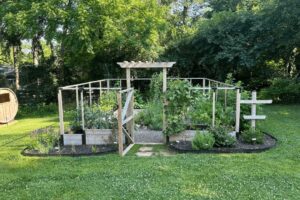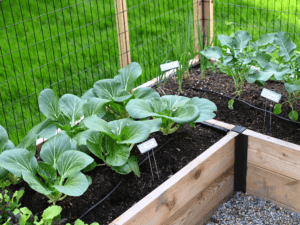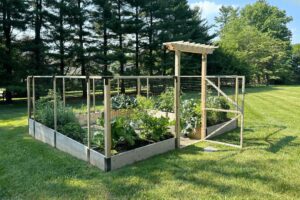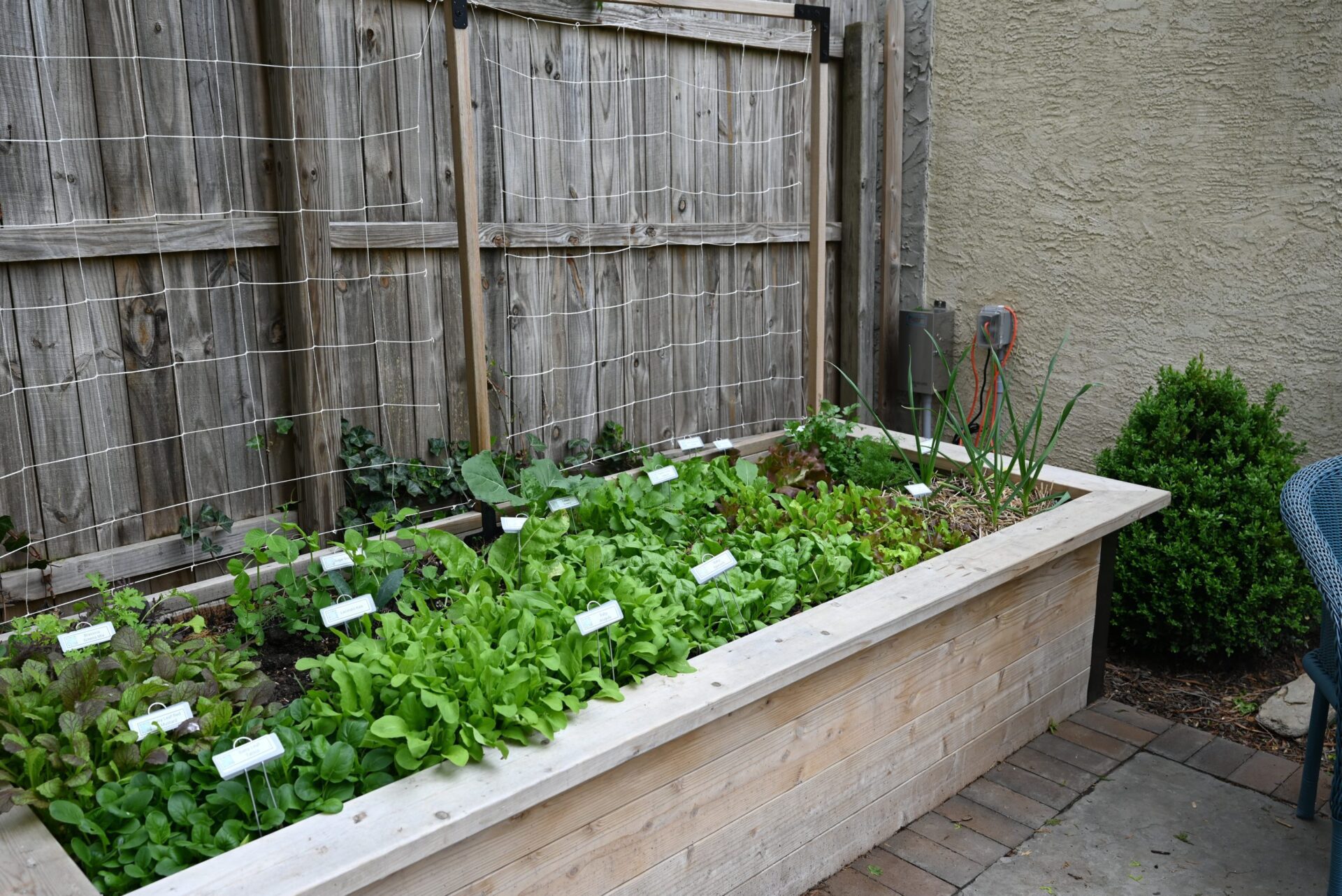
[et_pb_section fb_built=”1″ admin_label=”section” _builder_version=”4.16″ da_disable_devices=”off|off|off” global_colors_info=”{}” da_is_popup=”off” da_exit_intent=”off” da_has_close=”on” da_alt_close=”off” da_dark_close=”off” da_not_modal=”on” da_is_singular=”off” da_with_loader=”off” da_has_shadow=”on”][et_pb_row admin_label=”row” _builder_version=”4.16″ background_size=”initial” background_position=”top_left” background_repeat=”repeat” global_colors_info=”{}”][et_pb_column type=”4_4″ _builder_version=”4.16″ custom_padding=”|||” global_colors_info=”{}” custom_padding__hover=”|||”][et_pb_text _builder_version=”4.27.2″ _module_preset=”default” text_text_color=”#000000″ link_font=”|700|||on|||#000000|” link_text_color=”#000000″ header_2_line_height=”1.5em” header_2_font_size_tablet=”” header_2_font_size_phone=”23px” header_2_font_size_last_edited=”on|phone” global_colors_info=”{}”]
Starting a Container or Raised Bed Garden
Starting a garden is an exciting way to cultivate your own food, connect with nature, and create a personalized outdoor space. Whether you’re working with a spacious backyard or a small patio, choosing the right gardening method is crucial for success. From container gardening to raised beds, each approach has its own set of advantages and challenges. In this guide, we’ll explore the key factors to consider when starting a garden and help you determine the best option for your needs. Whether you’re aiming for convenience or long-term growth, there’s a perfect gardening style for everyone.
[/et_pb_text][et_pb_text _builder_version=”4.27.2″ _module_preset=”default” text_text_color=”#000000″ link_font=”|700|||on|||#000000|” link_text_color=”#000000″ header_2_line_height=”1.5em” header_2_font_size_tablet=”” header_2_font_size_phone=”23px” header_2_font_size_last_edited=”on|phone” global_colors_info=”{}”]
What to Consider When Starting a Garden
There are some key factors to consider when starting a garden that will help you determine what format of garden is right for you. First, location. Do you have a large yard that gets a lot of sunlight? Or are you trying to grow food on a small, shady patio? Although raised beds can be arranged to accommodate small spaces, such as a patio, container gardening in pots or grow bags remains the obvious solution for balcony gardening.
Does your backyard flood every time it rains? Although raised beds lift crops up from the ground, they will still wick up water and be affected by shifting soil. Do you prefer a garden that’s visible from your kitchen window? We recommend placing your garden in a visible and convenient zone, whether you’re installing raised beds into the landscape or growing lettuce on your balcony. This will help you see what’s ready to harvest and what needs to be maintained.
[/et_pb_text][et_pb_image src=”https://backyard-eats.com/wp-content/uploads/2023/12/Copy-of-DSC_6732-scaled.jpeg” title_text=”Copy of DSC_6732″ show_bottom_space=”off” _builder_version=”4.27.2″ _module_preset=”default” custom_margin=”20px||20px||true|false” global_colors_info=”{}”][/et_pb_image][et_pb_text _builder_version=”4.27.2″ _module_preset=”default” text_text_color=”#000000″ link_font=”|700|||on|||#000000|” link_text_color=”#000000″ header_2_line_height=”1.5em” header_2_font_size_tablet=”” header_2_font_size_phone=”23px” header_2_font_size_last_edited=”on|phone” global_colors_info=”{}”]
Pros of Container Gardening
On the other hand, gardening in smaller containers – like pots or grow bags – can provide several benefits to home gardeners. Unlike an in-ground garden, you don’t need a large yard or outdoor space to grow food in containers. You can start gardening on your patio or even grow herbs on your windowsill. For the beginner home gardener, starting small can seem less intimidating than immediately investing in a larger garden space. This can help you build confidence in your skills as a gardener. You can always expand or change your garden format in the future.
Container gardening is also flexible in terms of positioning and design. You can relocate garden pots more easily than a raised bed garden or in-ground garden – or even move containers inside for winter, depending on your climate. You can also place containers higher up (for example, on a table) if bending or kneeling down to ground level is difficult for you. As a side effect of this added height, your garden will also struggle less with weeds!
[/et_pb_text][et_pb_image src=”https://backyard-eats.com/wp-content/uploads/2024/10/pexels-kenzero14-22610767.jpg” title_text=”pexels-kenzero14-22610767″ show_bottom_space=”off” _builder_version=”4.27.2″ _module_preset=”default” custom_margin=”20px||20px||true|false” global_colors_info=”{}”][/et_pb_image][et_pb_text _builder_version=”4.27.2″ _module_preset=”default” global_colors_info=”{}”]
Photo by Kenneth Surillo on Pexels
[/et_pb_text][et_pb_text _builder_version=”4.27.2″ _module_preset=”default” text_text_color=”#000000″ link_font=”|700|||on|||#000000|” link_text_color=”#000000″ header_2_line_height=”1.5em” header_2_font_size_tablet=”” header_2_font_size_phone=”23px” header_2_font_size_last_edited=”on|phone” global_colors_info=”{}”]
Cons of Container Gardening
Despite these benefits, container gardening can be challenging due to soil and water limitations. Yes, a small collection of planters is fairly easy to water by hand. However, in general plant pots dry out quicker than other types of garden beds. This means you will need to water them more frequently. Likewise, they’re also more affected by temperature fluctuations which can add heat stress to your crops.
Because container gardens aren’t a self-sustaining system, they also require maintenance in terms of soil nutrients and balance. This means you will have to frequently add fertilizer to your pots, in order to provide the crops you want to grow with enough nutrients to produce fruit.
Another considerable limitation of container gardening is planter size. Many edible crops – including indeterminate – have strong root systems. In a cramped environment, plants won’t reach their full potential and you might be disappointed with your harvest. Squash, melons, and cucumbers, for example, are sprawling vining plants that can quickly outgrow their pots and begin to take over the surrounding space. These vining tendencies can be managed with trellises or fencing – however, it’s more difficult to add structures and sturdy cages to containers than it is in an established raised bed system. On a similar note, root crops like carrots and turnips also require a container that’s deep enough for them to develop fully. While container gardening’s compact size makes it more flexible in terms of layout, lack of space or infrastructure can limit what you can successfully grow in terms of food. If you have a patio garden then shallow-rooted plants like baby grees, lettuce, or tender herbs like cilantro and dill might be best for you.
[/et_pb_text][et_pb_image src=”https://backyard-eats.com/wp-content/uploads/2024/06/13-1.jpg” title_text=”13″ show_bottom_space=”off” _builder_version=”4.27.2″ _module_preset=”default” custom_margin=”20px||20px||true|false” global_colors_info=”{}”][/et_pb_image][et_pb_text _builder_version=”4.27.2″ _module_preset=”default” text_text_color=”#000000″ link_font=”|700|||on|||#000000|” link_text_color=”#000000″ header_2_line_height=”1.5em” header_2_font_size_tablet=”” header_2_font_size_phone=”23px” header_2_font_size_last_edited=”on|phone” global_colors_info=”{}”]
Pros of Raised Bed Gardening
Raised bed gardens offer many of the same benefits of container gardens: including control over growing conditions and design. As more permanent structures, raised beds can also support a wider variety of crops and sturdier structural additions than planters.
First, raised beds are customizable to your landscape. You can choose where to place raised beds in your yard based on factors like sunlight, water drainage, and slope. (We recommend 6-8 hours of sunlight for best success with most annual crops.) When designing your raised beds, you can also add enough height to meet your food-growing goals and accessibility needs. For example, we recommend a minimum of 12” of growing depth to allow the roots of annual plants to fully develop and support a mature plant; however, 18-24” can also be effective and easier to reach. Keep in mind that if you’re adding trellises or other vertical structures to your garden, that will also increase the height of your plants and how far you need to reach.
One significant advantage of raised beds is their ability to control soil conditions. Like any container, raised beds do require a careful balance of soil nutrients and drainage for healthy annual plants. However, this also means you can start your raised bed garden with an ideal soil blend free from contaminants and full of microscopic life.
Another design advantage of raised bed gardening is the ability to add additional infrastructure, such as fencing against pests or trellising to support vining plants. This could be as simple as a bamboo pyramid planted in a raised bed, or framed fencing built directly into the structure of the beds like with these metal corners. If you’re gardening on your patio, you might not worry about deer nibbling on your veggies – but if you’re going to build a raised bed garden in your backyard, you should be able to enjoy the harvest too! For example, we recommend 5-6 ft fencing to deter deer or groundhogs from jumping or climbing (respectively) into garden areas.
Another beneficial form of raised bed infrastructure is drip irrigation, which can water your plants automatically at the roots every day so they receive the optimal amount of moisture, which will help your plants thrive.
[/et_pb_text][et_pb_image src=”https://backyard-eats.com/wp-content/uploads/2024/06/19.jpg” title_text=”19″ show_bottom_space=”off” _builder_version=”4.27.2″ _module_preset=”default” custom_margin=”20px||20px||true|false” global_colors_info=”{}”][/et_pb_image][et_pb_text _builder_version=”4.27.2″ _module_preset=”default” text_text_color=”#000000″ link_font=”|700|||on|||#000000|” link_text_color=”#000000″ header_2_line_height=”1.5em” header_2_font_size_tablet=”” header_2_font_size_phone=”23px” header_2_font_size_last_edited=”on|phone” global_colors_info=”{}”]
Cons of Raised Bed Gardening
Although we believe that raised beds are a great medium for growing food, there are a few drawbacks. For example, they require a larger amount of land to build on than a patio – although we have also built patio-side raised beds before! And while structural upgrades like fencing can help protect your garden against pests, some people find the look of a boxy garden uninviting. If that sounds like you, consider planting native and pollinator-friendly perennial plants around a raised bed garden area for a more natural look – like in this family-friendly space.
However, if you primarily want to grow edible perennials – like berries or fruit trees – raised beds might not be right for you. Unlike annual plants, which tend to have relatively shallow root systems, perennial plants have stronger and deeper roots. Native perennials also tend to deal better with in-ground soil than annuals, and can quickly outgrow raised bed spaces. There are some exceptions – like mint or strawberries, which tend to “take over” undefined zones – but in general, we recommend raised beds for annual crops and in-ground beds for edible perennials.
[/et_pb_text][et_pb_text _builder_version=”4.27.2″ _module_preset=”default” text_text_color=”#000000″ link_font=”|700|||on|||#000000|” link_text_color=”#000000″ header_2_line_height=”1.5em” header_2_font_size_tablet=”” header_2_font_size_phone=”23px” header_2_font_size_last_edited=”on|phone” global_colors_info=”{}”]
Why We Recommend Raised Beds
Despite a few drawbacks, raised beds remain one of the most versatile and rewarding gardening methods. The ability to control soil quality and create an optimal growing environment makes them an excellent choice for home gardeners, especially for those growing annual vegetables and herbs. Raised beds offer long-term benefits, from better water management to ease of access, making gardening more manageable and efficient. Whether you’re looking to maximize your harvest, protect your plants from pests, or create a low-maintenance system with irrigation, raised beds provide a durable and customizable solution that adapts to your space and needs.
Whether you want the flexibility of portable pots or the structure of a raised bed, starting small and expanding over time is a great way to gain confidence in your gardening skills. Ready to get growing? Book a consultation today to start planning your dream garden and enjoy the rewards of fresh, homegrown produce right at your fingertips!
[/et_pb_text][et_pb_button button_url=”@ET-DC@eyJkeW5hbWljIjp0cnVlLCJjb250ZW50IjoicG9zdF9saW5rX3VybF9wYWdlIiwic2V0dGluZ3MiOnsicG9zdF9pZCI6IjU4MjY0In19@” url_new_window=”on” button_text=”BOOK A CONSULTATION” button_alignment=”left” button_alignment_tablet=”left” button_alignment_phone=”left” button_alignment_last_edited=”on|tablet” disabled_on=”off|off|off” _builder_version=”4.27.0″ _dynamic_attributes=”button_url” _module_preset=”737bea5a-e063-4b24-af3f-21ce28f0bf38″ button_bg_color=”gcid-3b5ac83a-684c-4379-a559-60b2aa9e8157″ button_border_color=”gcid-3b5ac83a-684c-4379-a559-60b2aa9e8157″ button_letter_spacing=”1px” button_font=”Roboto|700||on|||||” z_index=”90″ custom_margin=”0px|0px|30px|0px|false|false” custom_margin_tablet=”0px|0px|0px|0px|false|false” custom_margin_phone=”0px|0px|0px|0px|false|false” custom_margin_last_edited=”on|desktop” locked=”off” global_colors_info=”{%22gcid-3b5ac83a-684c-4379-a559-60b2aa9e8157%22:%91%22button_border_color__hover%22,%22button_bg_color%22,%22button_border_color%22%93}” button_text_color__hover_enabled=”on|hover” button_text_color__hover=”#844B67″ button_bg_enable_color__hover=”on” button_border_color__hover=”#88667b” button_border_color__hover_enabled=”on|desktop”][/et_pb_button][/et_pb_column][/et_pb_row][/et_pb_section]


